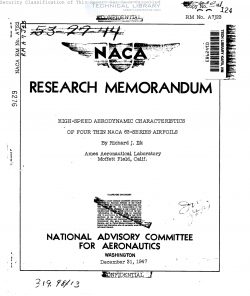naca-rm-a7j23
- Version
- 274 Downloads
- 2.28 MB File Size
- 1 File Count
- March 14, 2017 Create Date
- March 14, 2017 Last Updated
National Advisory Committee for Aeronautics, Research Memorandum - High Speed Aerodynamic Characteristics of Four Thin NACA 63 Series Airfoils

High—speed wind-twnel tests have been made of four thin NACA
65-series airfoil sections having a design lift coefficient of 0.2
with the uniform-load type of mean camber line to determine the
effectiveness of forward movement of the minim-pressure position
in improving the high-”speed lift characteristics of low-drag air-
foils. Section aerodgnamic characteristics at constant angles of
attack from -6° to 12 are presented for Each numbers from 0.5 to
0.875. The data obtained are compared to similar data for corre-
sponding NACA 64-series airfoils. '
For NACA 6-series airfoils less than lZ-percent chord thick,
movement of minim pressure from the 40-percent- to the 30-peroent-
chord location results in somewhat poorer high-speed aerodynamic
characteristics with regard to force-divergence Mach numbers and.
lift-curve slope, although the differences are small. The super-
critical-speed. lift characteristics of the NAGA 63-212 airfoil are
slightly better than those of the NACA 64-212 section. Thin EACA
6-series airfoils with minimum-pressure positions ranging from 30
percent to 60 percent of the airfoil chord appear to exhibit optinmm
high-speed aerodynamic characteristics with the minimum-pressure
position at 40 percent of the airfoil chord from the leading edge.
For even the thinnest airfoil sections, the range of lift coefficients
over which high force-divergence Mach numbers are maintained appears
to be sufficiently broad. to satisfy normal flight requirements.
High-speed wind-tunnel tests (reference 1) of a group of thin
NACA 64-, 65-, and. 66-series airfoil: having an ideal lift coeffi-
cient of 0.2 with the uniform-load type of mean camber line have
indicated increasingly better over-all high-speed aerodynamic charac-
teristics with forward movement of minimum pressure from the 60-percent
chord location to the 40-percent-chord location. To investigate the
possibility of additional gains in supercritical lift characteristics with
still further forward movement of minimum pressure on NACA 6-series air-
foils, tests of four NACA Sid-series airfoils having thickness-chord
ratios corresponding to those of the airfoils of reference 1 were
undertaken in the Amos 1- by 5%—foot high-speed wind tunnel.
From the results of this investigation it was hoped that an optimum
minizmm—pressure position could be determined for NACA 6-series
airfoils having a design lift coefficient of 0.2 to be employed on
high-speed aircraft.
| File | Action |
|---|---|
| naca-rm-a7j23 High Speed Aerodynamic Characteristics of Four Thin NACA 63 Series Airfoils.pdf | Download |

Comment On This Post